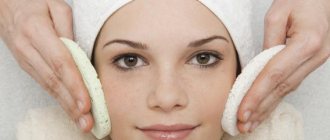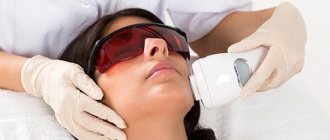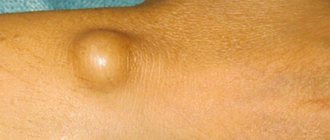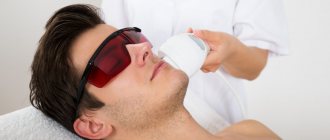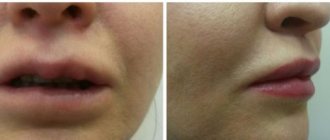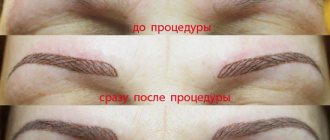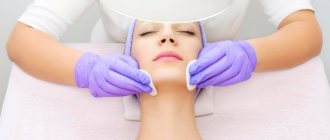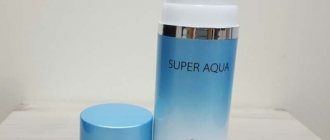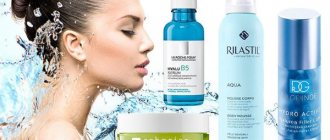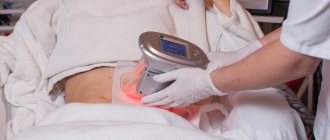Sodium chloride in cosmetology is a well-known inorganic salt, which is a component of various products and is part of the tissues and fluids of the body. Hollywood facial cleansing with calcium chloride is carried out in beauty salons and is distinguished by its high efficiency. With its help, it is possible to whiten the skin, eliminate inflammatory processes and get rid of minor rashes on the face. Facial cleansing with calcium chloride has a lot of advantages, but at the same time there are contraindications to its implementation.
Sodium chloride in cosmetology
Table salt is widely used as an ingredient in the preparation of cosmetics at home, and especially scrubs.
It is also used in the cosmetics industry, and many manufacturers use sodium chloride as a flavor enhancer, antiseptic, and viscosity enhancing agent. In cosmetology, the most common role of sodium chloride is as a thickener. Salt is commonly added to cosmetics to thicken the water phase of shampoos, cleansing facial scrubs and shower gels. Another common role of such a substance in the field of cosmetology is its use as an abrasive in gommages and scrubs.
When to use
Sodium chloride solution has been successfully used:
- at the time of surgery and after surgery to maintain plasma volume;
- when the body is dehydrated, which is caused by various diseases;
- for severe bleeding, severe burns and dispensation to maintain plasma volume;
- to reduce intoxication when a dangerous infection enters the body;
- for washing eyes during inflammatory and infectious processes, allergies and injuries;
- for rinsing the nose during colds;
- for inhalation for respiratory diseases;
- for dissolving different drugs when used together for injection.
Advantages and disadvantages of the procedure
Peeling with calcium chloride is usually carried out in beauty salons, and it is called Hollywood peeling. This procedure is recommended if there are a large number of blackheads on the skin that appear as a result of clogged pores. With the help of peeling, it is possible to whiten the skin, stop inflammatory processes and eliminate small pimples and blackheads. In fact, such cleansing is considered much more effective and efficient than mechanical cleaning.
Peeling with calcium chloride removes dead cells, helps destroy pathogenic microorganisms on the surface of the epidermis and whitens the skin well. In addition, this product helps eliminate fine wrinkles, evens out facial contours and has a rejuvenating effect.
Many women, after peeling with sodium chloride for the face, complain of severe dryness of the skin and flaking. In addition, pigmentation on the face and areas of uneven color of the skin may appear. Typically, such problems occur if you overdo it with the cleansing procedure or do it not quite correctly.
Experts highlight the following advantages of peeling with calcium chloride:
- has a gentle effect on the skin;
- the procedure takes a little time;
- can be used as needed;
- There is no pain or discomfort during peeling;
- the recovery period passes quite quickly;
- completely safe for the human body.
Despite the many advantages of peeling with calcium chloride, some patients note the following disadvantages:
- in the presence of damaged areas of the epidermis, there is a high risk of developing necrosis;
- after the procedure, the skin turns red and there is a feeling of tightness;
- It is not recommended for people with overly sensitive skin.
In order to get the maximum effect from the procedure and avoid the development of unpleasant consequences, peeling must be carried out in compliance with certain rules.
Contraindications
Despite the fact that potassium chloride is a safe means for exfoliating the face and body, you need to be especially careful when using it. This warning is due to its contraindications. Experts recommend excluding this type of skin cleansing if:
- skin is prone to excessive irritation or redness;
- dry and sensitive epidermis;
- a woman who is pregnant or breastfeeding;
- there are open wounds or inflammations on the skin.
However, the most important contraindication is individual intolerance to sodium chloride or other components. To identify such a problem, a test reaction should be carried out in advance. In this case, a small amount of the substance is applied to the skin of the back of the hand.
If after 5–10 minutes there is no reaction (irritation, redness), then you can use this peeling composition without fear. If such a check is not carried out, the risk of an allergic reaction increases in the future. The consequence of which will be the appearance of defects on the skin.
At the same time, many women, when exfoliating incorrectly, experience dryness, the appearance of age spots, redness and other problems.
However, you can avoid all the negative consequences of using sodium chloride-based cleansing only if you follow the rules of the procedure and the advice of specialists in the field of cosmetology and dermatology.
Features of the procedure
Sodium chloride is a derivative of hydrochloric acid and upon contact with the human dermis, the salt provokes a superficial burn, which is accompanied by the rejection of dead cells. If you include baby soap in the peeling, both components interact with each other and form a new substance - an insoluble calcium salt.
It is this that patients notice in the form of small white lumps, and it plays the role of an abrasive substance, under the influence of which the cleansing of the skin from worn-out cells is accelerated. All this leads to the launch of a protective mechanism, that is, the active restoration process of the skin begins.
The salon peeling procedure includes several stages:
- thoroughly cleanse faces of dirt and makeup;
- Apply a thick layer of baby soap to your face;
- apply calcium chloride over the soap solution with your hands and rub it in until pellets appear;
- massage the face for several minutes until all the product has rolled off;
- the residues are removed with warm water and the skin is lubricated with nourishing cream.
You can do peeling with calcium chloride at home, and the process is almost identical to the salon one. For the procedure, it is recommended to use a 5 or 10% solution of the product and baby soap. It is necessary to apply the solution to the epidermis of the face with a cotton pad and wait until it dries completely. After this, you need to apply a second, and if necessary, a third layer of the product. You should foam the baby soap, lather your face with it and massage until pellets form. After this, the remnants of the mask should be washed off with water and a nourishing cream should be applied.
How to exfoliate with baby soap and calcium chloride at home and an express method
As in any business, before you start practicing, it’s worth studying a little theory. Internet sites offer a lot of instructions on how to carry out peeling with soap and calcium chloride, gas-liquid or glycol on your own, but not all of them will teach you how to do it correctly and get the desired effect, given the greater availability than carbon.
We propose to consider the entire process of the procedure in stages:
Stage 1 – purchase of the drug in ampoules for facial cleansing
It is permissible to use only baby soap. At the pharmacy, purchase a liquid solution of calcium chloride 5% or 10% to prepare a scrub. It is better to start with a lower percentage of the drug to avoid excessive damage to the skin. The drug is distributed in ampoules. One ampoule will be sufficient for one procedure. Externally, a solution of calcium chloride is no different from ordinary water; it is a colorless and odorless liquid. You can learn about glycolic peeling at home here.
Stage 2 – preparing the facial skin before applying the scrub
The surface of the skin is cleansed with makeup remover. Then rinse with warm water. You need to wash your face carefully, avoiding excessive friction. Remains of moisture are removed with a napkin. Apply a rich cream to the skin around the eyes. This will protect it from accidental contact with a caustic substance.
Stage 3 – application of the drug
Using a cotton pad, apply the product to the skin of the face, carefully avoiding the eye and lip area. As soon as the first layer of the solution dries, repeat the application step 3-4 more times. If the skin is highly sensitive, then there should be fewer layers. After just a few minutes, a tingling and slight burning sensation begins to be felt.
Stage 4 – adding soap
Prepare soap foam with a small amount of water. It is important to remember that a reaction is only possible with baby soap. Apply the foam to the face with your fingers, then begin to gently massage the skin, following the massage lines. It is not recommended to linger on the same areas of skin for a long time, so as not to provoke irritation. Soon white lumps will begin to appear, which appear as a result of a chemical reaction - the formation of salt. As soon as the characteristic creaking of clean skin appears, all peeling components are washed off with warm water.
Video of peeling using baby soap and calcium chloride:
Experienced experimenters already have a more accelerated version of peeling - the express method. When all the necessary components are at hand, a soap solution is immediately prepared. The whole procedure is carried out in reverse order. First, the face is treated with soap foam. Then moisten your fingers with calcium chloride and begin to massage your facial skin well. The reaction occurs the same as in the original embodiment. As soon as the lumps clear the skin, they are washed off with warm water. You can learn about gas-liquid facial peeling by following the link.
Facial skin care after the procedure
The final stage of the procedure for this type of chemical peeling (on par with retinoic peeling) must be a face mask. When the skin is well cleansed, all the nutrients in the mask are able to penetrate deep into the layers of the epidermis.
It is advisable to formulate masks after peeling so that they have either a calming or anti-inflammatory effect. So, in order for the skin to recover faster and irritation to go away, you can prepare a mask based on oatmeal, any soft fruit and chamomile decoction. Oatmeal is ground with fruit pulp, then poured with hot broth. Apply the finished mixture warm to the face and leave for 15-20 minutes. As soon as the mask begins to dry out, wash it off with cool water and moisturize with cream.
If it is necessary to relieve inflammation from the skin after peeling, then prepare the following mask based on cosmetic clay, banana, essential oil with an anti-inflammatory effect (tea tree, geranium, rosewood, etc.) and herbal decoction. All ingredients are mixed well until a homogeneous mixture is formed, which is applied to the skin for 15-20 minutes. Then wash off with cool water. The skin is moisturized with cream.
It is important to know that the peeling process after exposure to calcium chloride will continue for the next 3-4 days. Therefore, the skin must be actively moisturized during this period.
Since any peeling activates the production of melanin pigment, there is a risk of developing age spots. To prevent the development of this effect, it is necessary to protect the skin from sun exposure using a cream with a high ultraviolet filter. This problem is especially relevant in the summer.
Video of facial skin care after peeling:
Cosmetologists recommend adhering to the following rules when using chemical peeling methods at home:
- The best time for the cleansing procedure is evening. During these hours, the whole body is tuned to get rid of everything unnecessary. In addition, there is enough time until the morning for the skin to calm down, irritation to go away, and the nutritional elements of the mask to be completely absorbed.
- One peeling procedure is not enough. It is necessary to carry out a course of several procedures at equal intervals of time. It is advisable to schedule any cleaning procedures during the colder months. Solar activity during this period is reduced, which reduces the risk of side effects.
- The minimum course includes 3 procedures no more than once a week. Next, a mandatory break of 2-3 months is taken.
- Use natural vegetable oils to nourish the skin instead of cream.
At this point, the peeling procedure with calcium chloride is considered complete. Many women who tried it on themselves noted a noticeable improvement in the appearance of their skin. In addition, the main advantages of peeling were: almost instant results, absence of pain and damage to the skin, and the possibility of frequent use. You can learn about deep facial peeling at home in this article.
Recommendations for performing the procedure
When peeling, it is not allowed to apply the product to the dermis in the area of the lips and eyes. Sodium chloride reduces skin moisture, that is, it dries it out. Taking into account this feature, after cleansing the face, it is necessary to make nourishing masks, the ingredients of which include chamomile infusion, banana puree or porridge from ground rolled oats.
You can relieve skin irritation after peeling with an infusion prepared from calendula or sage. If you add tea tree oil to the infusion for rubbing, you can quickly relieve inflammation on the face. It is best to carry out the procedure before bed, otherwise the skin simply will not have time to recover. It is not allowed to leave the solution on the epidermis for a long time, as it can cause hyperpigmentation of the skin. Before going outside after cleansing your face, you need to lubricate your face with protective agents depending on the time of year or. This will protect the skin from irritation and avoid increased pigmentation.
Reviews about peeling that can be heard from patients are mostly positive. Users talk about the high effectiveness of this cosmetic product and that with its help the skin becomes elastic and fresh, like Hollywood stars. When performing the procedure at home, it is important to follow all instructions, since ignoring them may result in facial burns, swelling, or severe redness.
“Rolling” effect
Girls and women who have once tried “rolling” with calcium chloride continue to use it almost their entire lives. First of all, they note the low cost and availability of peeling components. After all, not every woman can afford expensive procedures in a beauty salon. In second place is the opinion that there is an effect from the “skating”. After a series of procedures, the skin really becomes soft and tender, defects disappear. In addition, calcium chloride peeling is used by most to control excessive skin greasiness. After the first procedure, it becomes more matte.
If you perform the procedure in strict sequence according to the instructions, then a good result is guaranteed. In addition, they note that peeling can be easily done on your own and does not take much time at all. We also recommend that you familiarize yourself with Cora’s acid peeling in this material.
What do cosmetologists advise?
The exfoliation process after a calcium chloride peel can last three to four days. Therefore, during this period it is imperative to moisturize the skin.
This cosmetic method activates the production of melanin pigment. The risk of developing pigment spots increases. To avoid the development of such an effect, you need to use a cream that has a high ultraviolet filter. This problem affects many women in the summer.
According to reviews of peeling with calcium chloride and baby soap left by cosmetologists, this is an effective technique. Professionals recommend adhering to some rules:
- The best time to perform a skin cleansing procedure is evening. It is at this time of day that the body is set to “get rid” of excess. Until the morning, the skin will calm down and the nourishing components of the mask will be well absorbed.
- Once is not enough. A course of several procedures will be required. Minimum course – 3 times. Peel no more than once a week. Then take a break between procedures for two to three months.
- To nourish the skin, you can use vegetable oils instead of cream.
It is advisable to peel during the colder months of the year.
Reviews of peeling with calcium chloride and baby soap from ordinary women are positive. Many of them noticed significant improvements in the appearance of their facial skin immediately after the procedure.
Skin care after the procedure
The final stage of the cosmetic procedure is applying a face mask. When the skin is already cleansed, it needs to be soaked. Nutrients penetrate well deep into the epidermis layer.
The mask after the procedure should have either a calming or anti-inflammatory effect. It is necessary for the speedy restoration of facial skin. It is necessary to ensure that the irritation goes away.
